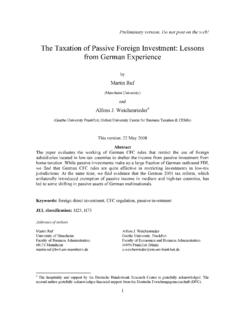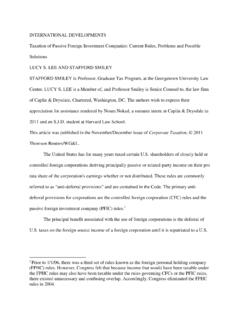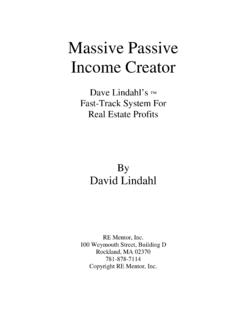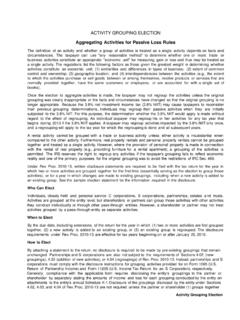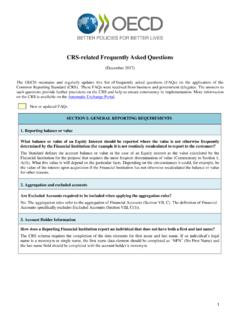Transcription of FATCA Final Regulations: Definitions List - Allen & Overy
1 FATCA Final regulations : Definitions ListBy Craig CohenChapter 4 of the Internal Revenue Code and the Treasury regulations thereunder commonly known as the Foreign Account Tax Compliance Act, or FATCA consists of a complex web of withholding and reporting mechanics. These rules and regulations are expressed in a language of defined terms unique to FATCA , populated largely with internal cross-references and nearly incomprehensible to even the most experienced tax practitioner. As such, this concise list of the most commonly used defined terms under the Final FATCA Treasury regulations is in tended to act as a stand-alone reference for understand ing and applying the key terms and concepts under FATCA .
2 Of course, these materials are not intended to be a substitute for a careful reading of the relevant Treasury regulations , and for this reason each entry includes a citation. Defined terms used elsewhere in this Definitions list are highlighted in content of this article was originally published in Tax Notes International, Volume 70, Number 8, May 20, Final regulations : Definitions Final Regulation: Definitions ListCraig Cohen is senior counsel with Allen & Overy in New YorkAccount holder: section (a)(3)(i): the person listed or identified as the holder of a financial account with the FFI that maintains the financial account, regardless of whether such person is a flow-through entity. In the case of a financial account held by an entity that is disregarded for federal tax purposes, the financial account shall be treated as held by the person owning such NFFE: section (c)(1)(iv): any entity if less than 50 percent of its gross income for the preceding calendar year is passive income and less than 50 percent of the weighted average percentage of assets (tested quarterly) held by it are assets that produce or are held for the production of passive or similar business: section (e)(2).
3 An entity is considered to be engaged in a banking or similar business if, in the ordinary course of its business with customers, the entity accepts deposits or other similar investments of funds and regularly engages in one or more of the following activities:(A) makes personal, mortgage, industrial, or other loans or provides other extensions of credit;(B) purchases, sells, discounts, or negotiates accounts receivable, installment obligations, notes, drafts, checks, bills of exchange, acceptances, or other evidences of indebtedness;(C) issues letters of credit and negotiates drafts drawn thereunder;(D) provides trust or fiduciary services;(E) finances foreign exchange transactions; or(F) enters into, purchases, or disposes of finance leases or leased entity is not considered to be engaged in a banking or similar business if the entity solely accepts deposits from persons as collateral or security pursuant to a sale or lease of property or pursuant to a similar financing arrangement between such entity and the person holding the deposit with the : section (e)(2)(ii).
4 A unit, business, or office of an FFI that is treated as a branch under the regulatory regime of a country or is otherwise regulated under the laws of such country as separate from other offices, units, or branches of the FFI and that maintains books and records separate from the books and records of other branches of the FFI; including units, businesses, and offices of an FFI located in the country in which the FFI is created or organized. All units, businesses, or offices of a participating FFI in a single country shall be treated as a single branch, and a financial account will be treated as maintained by a branch if the rights and obligations of the account holder and the participating FFI with regard to such account (including any assets held in the financial account) are governed by the laws of the country of the : section (b)(9): any person, or foreign, that, in the ordinary course of a trade or business during the calendar year, stands ready to effect sales to be made by others.
5 Including an obligor that regularly issues and retires its own debt obligations, a corporation that regularly redeems its own stock, and a clearing organization that effects sales of securities for its members; excluding an international organization that is an exempt beneficial owner and which redeems or retires an obligation of which it is the issuer, a stock transfer agent that records transfers of stock for a corporation if the nature of the activities of the agent is such that the agent ordinarily would not know the gross proceeds from sales, an escrow agent that effects no sales other than transactions incidental to the purpose of the escrow (such as sales to collect on collateral), or a corporation that issues and retires long-term debt on an irregular finance company: section (e)(5)(i)(E).
6 An entity whose primary activity is to enter into financing (including the extension of credit) or leasing transactions with or for suppliers, distributors, dealers, franchisees, or customers of such entity or of any member of such entity s expanded affiliated group that is an active deemed-compliant FFI: section (f)(2): an FFI that is:(i) a nonregistering local bank;(ii) an FFI with only low-value accounts;(iii) a sponsored, closely held investment vehicle; or(iv) a limited life debt investment 4 status: section (b)(17): a person s status as a person, a specified person, an individual that is a foreign person, a participating FFI, a deemed-compliant FFI, a restricted distributor, an exempt beneficial owner, a nonparticipating FFI, a territory financial institution, an excepted NFFE, or a passive organization: section (b)(18): an entity that is in the business of holding securities for its member organizations or clearing trades of securities and transferring, or instructing the transfer of, securities by credit or debit to the account of a member without the necessity of physical delivery of the entity: section (b)(2).
7 An entity that is separate in form from a foreign sovereign or that otherwise constitutes a separate juridical entity, provided that:(i) the entity is wholly owned and controlled by one or more foreign sovereigns directly or indirectly through one or more controlled entities;(ii) the entity s net earnings are credited to its own account or to other accounts of one or more foreign sovereigns, with no portion of its income inuring to the benefit of any private person; and(iii) the entity s assets vest in one or more foreign sovereigns upon account: section (b)(3)(ii): an arrangement for holding a financial instrument, contract, or investment (including, but not limited to, a share of stock in a corporation, a note, bond, debenture, or other evidence of indebtedness, a currency or commodity transaction, a credit default swap, a swap based upon a nonfinancial index, a notional principal contract, an insurance or annuity contract, and any option or other derivative instrument) for the benefit of another institution: section (e)(3).
8 Any entity whose gross income attributable to holding financial assets and related financial services for the benefit of one or more other persons (eg, custody, account maintenance, and transfer fees; commissions and fees earned from executing and pricing securities transactions; income earned from extending credit to customers with respect to financial assets held in custody or acquired through such extension of credit; income earned on the bid-ask spread of financial assets; and fees for providing financial advice and for clearance and settlement services) equals or exceeds 20 percent of the entity s gross income during the shorter of:(1) the three-year period ending on December 31 of the year preceding the year in which the determination is made.
9 Or(2) the period during which the entity has been in existence before the determination is entity with no operating history as of the date of the determination is considered to be a custodial institution if the entity expects to meet the gross income threshold described above based on its anticipated functions, assets, and employees, with due consideration given to any purpose or functions for which the entity is licensed or regulated (including those of any predecessor).Deemed-compliant FFI: section (f): an FFI that is:(1) a registered deemed-compliant FFI; (2) a certified deemed-compliant FFI;(3) an owner-documented FFI; or(4) a QI branch of a financial institution that is a reporting Model 1 account: section (b)(3)(i): FATCA Final regulations : Definitions (1) A commercial, checking, savings, time, or thrift account, or an account that is evidenced by a certificate of deposit, thrift certificate, investment certificate, passbook, certificate of indebtedness, or any other instrument for placing money in the custody of an entity engaged in a banking or similar business for which such institution is obligated to give credit (regardless of whether such instrument is interest bearing or non-interest bearing).
10 Including, for example, a credit balance with respect to a credit card account issued by a credit card company that is engaged in a banking or similar business; or(2) Any amount held by an insurance company under a guaranteed investment contract or under a similar agreement to pay or credit interest thereon or to return the amount depository account does not include a negotiable debt instrument that is traded on a regulated market or over-the-counter market and distributed and held through financial institutions, or an advance premium or premium institution: section (e)(1)(i): any entity that accepts deposits in the ordinary course of a banking or similar : section (b)(29): withholding certificates, written statements, documentary evidence, and other documents that may be relevant in determining a person s status as a person, a specified person, an individual that is a foreign person, a participating FFI, a deemed-compliant FFI, a restricted distributor, an exempt beneficial owner, a nonparticipating FFI, a territory financial institution, an excepted NFFE, or a passive NFFE.


